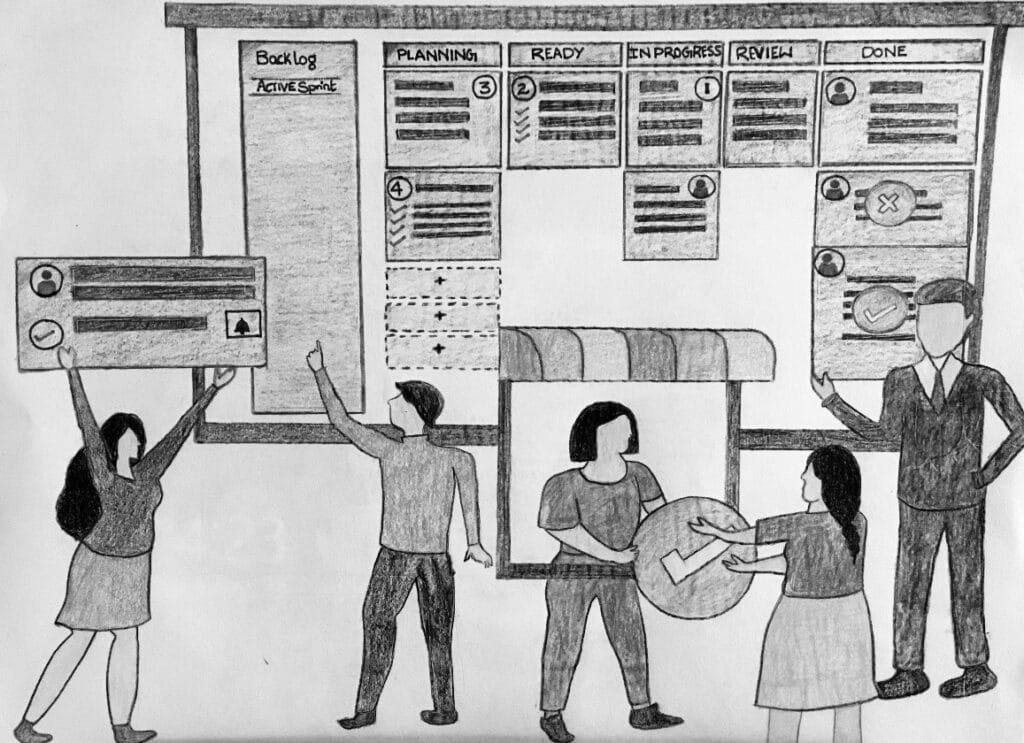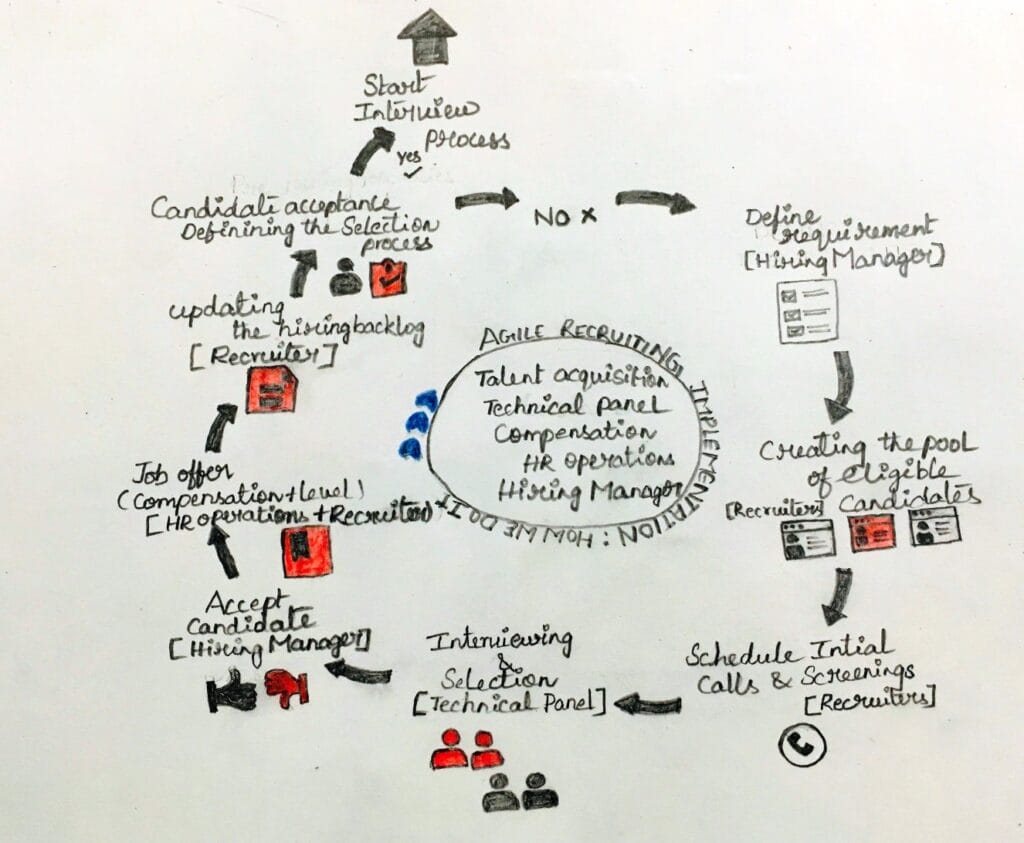A few years back we were desperately looking for a hiring platform/tool which can fulfill our talent acquisition needs by ensuring team collaboration.
It was also a time when the scrum was widely used by software development teams in coMakeIT.
As we recruit employees for engineering and product development roles throughout the year, one day our manager advised us to explore the scrum way of working and Jira as a tool for hiring teams. We as talent acquisition wondered how recruitment would be revolutionized if we implement agile recruiting.
We started to think “how these sprint retrospective, stand-ups, and backlogs can solve our problems?” Ultimately it gave us a solution making the lives of our recruiters, hiring managers, and the candidate’s easier.
The major principle of the agile process is to promote sustainable development. The developers and users should be able to maintain a certain velocity and improve quality continuously.
How agile manifesto differs from the normal process?
- In the case of a normal process, communication is fluid and happens when a need arises. Whereas in agile, communication is continuous on issues that block progress. The process is the means, not a goal in itself.
- The normal process relies more on tools that are barely responsive and are less likely to meet customer needs. On the other hand, agile manifesto is people-driven who respond to business needs and drive the development process.
Our story of the agile scrum in hiring

Instead of explaining it as a manual, I would rather proudly call it “Our story of scrum hiring”.
Once we have started using scrum in our recruitment processes, we have experienced some improvements.
Agility introduced by scrum helped us to respond quickly to short-term changes, like shifting based on market trends, behavioral transformation, technological interventions, and responding to change over following a plan.
- In the first step of implanting scrum, we chose Jira software for organizing our work.
- While it is modest in its framework, it highly helped us for collaborating and to deal with the changes in hiring. We made it lightweight and easily understandable.
- Each hiring sprint will be time-boxed to 1 week, and we have two sprints in each prioritized backlog (open position list). How much we achieved in the week sprint depends on selecting and prioritizing the requirements in the backlog by discussing it with the delivery managers.
- Daily scrum meetings are systematically planned at the same time and last for about 10 to 15 min where we discuss tasks/priorities for that day. During these recruitment stand-ups, we answer the following questions in addressing potential roadblocks:
- What we achieved till now.
- How many profiles are sourced and screened towards each requirement?
- What are the other sources we can explore if we are unable to get enough profiles for certain requirements?
- Any pending feedbacks that need immediate attention to close the position.
- Any high priority requirements which need immediate action
- Our scrum board gives a clear picture of the backlog for the team. Backlog consists of one or more sprints that team members can update the board with.
Grooming the backlog is essential because the requirements in the backlog are not always accurate and complete, they must be regularly updated for the consumption of our team.

If the requirements are big, then we break the sprint into two parts.
- Sourcing sprint: This starts with a meeting with the hiring manager to draft a first version of the job requirement. Then follows the estimation of the smaller chunks along with revisiting prioritization by the talent acquisition team and hiring manager. Comparatively more sourcing and pre-screening by recruiters and less scheduling of the interviews with the technical panel will happen in this sprint.
- Scheduling sprint: is more interviews and less sourcing. If the interviews are successful in the first round, then great! However, if the hiring manager rejected those candidates in sprint 1, that will allow us to go over the profiles again and fine-tune the job requirement in sprint 2.
Scheduling the various stages of interviews with the panel will happen in this sprint.

- In between, backlog refinement is done which decides on the requirements that will be at the top of the backlog and ready for the next sprint.
This includes adding new requirements to the backlog for better clarity or refinement to the existing or pending requirements, estimating timelines, and deleting offered requirements from the backlog.
- If prioritization clashes, we will rebuild the backlog and discuss the possibilities to achieve the next step of forwarding in daily scrum meetings.
- At the end of each sprint, we do retrospective which allows us to pause and reflect on how things have been going, and then, based on those reflections, we identify the improvement points. By doing retrospective frequently, our team could continuously improve performance. Due to this, the talent acquisition team and delivery managers get the opportunity to collaborate better.
Since the recruiters will be the first person to touch base with a potential candidate, the way we interact with job seekers can be a great opportunity to establish trust. Hence, we take this retrospective as an opportunity to empower to transmit the kind of experience the hiring manager ready to deliver in terms of:
- Any change in roles and responsibilities of the job description,
- Pay structure
- Timelines for the project to start.
- Agile in hiring helped us greatly to systematically answer the questions by hiring managers such as:
- How many profiles were sourced for each requirement?
- How many offers were released?
- Competences of shortlisted candidates
This way of agile recruiting has especially helped us with newly opened roles for which we haven’t hired before, or ones with hard-to-find requirements. Every sprint allowed us to learn from the candidates we sourced, and to iterate on the job requirements with the hiring manager.
- We end the sprint by releasing the offers for the selected candidates or we will restart sourcing with the renewed refinement in adverse cases.
- We change our backlog after each sprint based on the changing business priorities and this helped our business in all the three phases: rapid growth, stable times, and team reshuffling.
How agile recruiting made our lives easier
- It brought momentum to the recruitment process
Painfully slow recruitment processes can ruin the candidate’s experience, but it also can ruin recruiter motivation. There’s nothing more unsatisfying as finding a star candidate and losing them for the age-long recruitment process.
Finally, with agile recruiting, we have more daily touchpoints and shorter sprints while the hiring managers are better engaged with the recruitment process. In general, this has increased delight in the organization regarding hiring
- More collaboration
More contact than usual, continuous communication, and regular meetings mean better teamwork between recruiters, hiring managers as well as a technical panel on the team.
- More frequent feedbacks
With the old-school recruiting process, recruiters present candidates at the very end of the process of sourcing and pre-screening. While a lot of work is done by the hiring team, there was a high possibility that the candidate profile wasn’t really what the hiring manager had in mind. That would take hours, days, and sometimes weeks of time to know that result!
The internal recruitment process is represented through this cycle.

At the end of each hiring sprint, we as a team join in time-boxed meetings to do the sprint assessment, in which we discuss the outcome of the sprint. Then we do a sprint retrospective by discussing the learning around people’s capability, process, and roles which include metrics such as the number of offers released, candidate experience, etc. This determines the success of our sprint. We don’t forget to celebrate our success though.
Finally, this facilitated us to stop guessing and put a method to how we prepare for the incoming requirements.
We will be happy to share this best practice with the HR fraternity should anyone be interested in knowing more about it. Please do so by sending an email to u>info@info.com</u.




